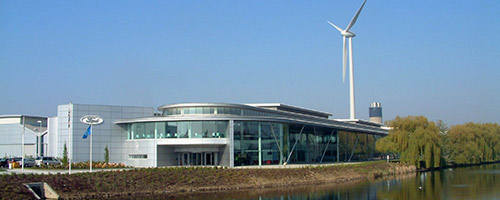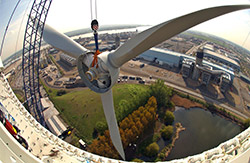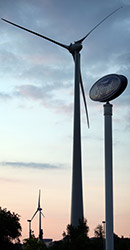
Ford's Dagenham Diesel Center in the U.K. became the world’s first automotive plant powered solely by wind.
What it takes to be a green manufacturing facility
Story by Alice Arutoff
It’s more than just recycling paper and turning the lights off at the end of the day; being green means looking at all aspects of a facility and creating a plan that will positively impact the environment. It’s a continuous process that is ever changing and ensures that best practices are used and shared across the globe in Ford’s manufacturing sites.
“Our manufacturing operations have integrated sustainable goals and indicators into their operations,” said Sue Cischke, group vice president, Sustainability Environment and Safety Engineering. “This effort has really become evident in the progress we’ve made on energy use and water reduction in our manufacturing operations.”
 |
| Wind Turbine at Dagenham |
Utilizing Alternative Power Sources
Dagenham Diesel Center in the United Kingdom became the world’s first automotive plant powered solely by wind. It continues to be 100 percent powered by wind-generated electricity after the addition of a third turbine earlier this year to meet increased demand.
 |
| Wind Turbine at Genk |
Bridgend Engine Plant in Wales has used photovoltaic – solar – panels to create energy for the plant since the late 1990s.
“Such developments demonstrate the substantial progress we are making and our commitment to further improving our environmental performance,” said Wolfgang Schneider, vice president, Governmental and Environmental Affairs, Ford of Europe. “We are building on that progress and continuing to look at ways to further reduce our carbon footprint.”
 Traveling to North America, Ford’s Fumes-to-Fuel system emerges as a source to create alternative energy.
Traveling to North America, Ford’s Fumes-to-Fuel system emerges as a source to create alternative energy.
The Paint Emissions Concentrator, piloted at Dearborn Truck Plant and Michigan Assembly Plant, concentrates VOC paint emissions at a 2000-to-1 ratio, as compared to a 10-to-1 ratio with the traditional carbon wheel technology, for use as a fuel. The fuel can be used in place of natural gas in a thermal oxidizer, creating a self-sustaining system.
Fumes-to-Fuel extends the potential of the Paint Emissions Concentrator and can be used for energy generation. At the Oakville Assembly Complex in Ontario, the Fumes-to-Fuel system includes both an internal combustion engine and a 300 kW molten carbonate fuel cell. The Paint Emissions Concentrator has the potential to reduce CO2 emissions by 80 percent as compared to traditional abatement technology, and when used in conjunction with a fuel cell, the system has the potential to eliminate nitrogen oxide (NOx) emissions, a major element of smog.
Michigan Assembly Plant will also install a 500 kW photovoltaic electricity system and use gas from a local landfill to offset traditional energy dependence – fossil fuel and natural gas.
With an expected 30 percent increase in vehicle production this year alone, Asia Pacific and Africa continues to reduce energy consumption. Compared to 2009, APA has reduced energy consumption by 11 percent per vehicle.
The new Thailand FTM Assembly Plant and Chongqing Assembly Plant will use a solar array to power efficient LED lighting systems.
Water High in Demand
Since launching the company's Global Water Conservation Initiative in 2000, global manufacturing facilities have saved more than 10.5 billion gallons of water – a 62.4 percent reduction. Per vehicle, water use has decreased nearly 45 percent from 2000 to 2009.
 |
| Take a deeper look at Ford Motor Company's global footprint with our interactive map of worldwide manufacturing operations. |
Located in the Sonoran Desert in Mexico, the Hermosillo Stamping and Assembly Plant has limited access to water – a necessary resource for the manufacturing process. An extended drought and population increase has led to a strain on water supply.
Hermosillo Stamping and Assembly Plant installed a biological water treatment system, membrane biological reactor, which uses an ultra-filtration membrane process followed by reverse osmosis making 55 percent of the plants wastewater for reuse. The treated water can also be used in irrigation, further raising the amount of recycled wastewater to 65 percent.
“Water in Mexico, especially for manufacturing facilities, is not an abundant resource,” said Luis Lara, director, Environment, Ford of Mexico. “The water treatment systems in Mexico make efficient use of the water supply, limiting the consumption of fresh water to personal service.”
The Chennai Assembly Plant in India and the Chihuahua Engine Plant in Mexico also utilize this wastewater filtration system improving their impact on the surrounding communities.
Continuous Sustainable Efforts
Chennai Assembly Plant was the first manufacturing facility to introduce the use of cement kilns for waste management. Now an industry benchmark, Chennai is a zero waste to landfill facility.
“There is a lot of creativity across the region and sometimes all you need to do is bring these people and ideas together and share,” said Gary Johnson, executive director, Manufacturing, Asia Pacific and Africa. “We find that sites are hungry for more information on ways to improve performance. It also drives teamwork and once one site demonstrates that something is achievable the others quickly pick it up.”
 |
| The largest "living roof" in the automotive industry is at Ford Motor Company's Rouge Complex |
In 2003, Ford worked to transform the Rouge, an icon of the 20th century’s Industrial Revolution, into a 21st century symbol of responsible manufacturing. The most notable endeavor of the project is its innovative storm-water management system, including the largest “living” roof in the automotive industry.
Sedum, a drought-resistant perennial groundcover, covers 10.4 acres of roof at the Rouge’s Dearborn Truck Plant. Not only does the plant life help diminish storm-water runoff, it doubles the life of the roof, provides insulation, reduces cooling and heating demands by 5 percent, and absorbs carbon dioxide to reduce greenhouse gases.
“The Ford Rouge Center continues to be a hallmark of sustainable manufacturing,” said Cischke. “The green technologies utilized in its redevelopment and operation inspires others to adopt similar solutions.”
RELATED TOPICS
• Report: Ford Motor Company's Blueprint for Sustainability | The Future at Work
• Charts: Ford Motor Company Water Use Data
• Letter: Ford Motor Company President and CEO Alan Mulally on Our Environmental Commitment



